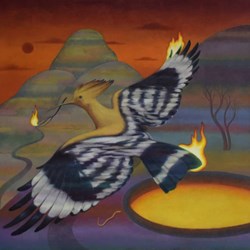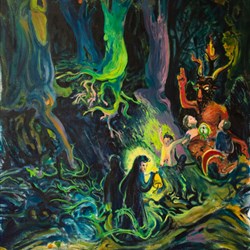Zohreh Zavareh
25 Aug - 1 Sep, 2023

Statement:
Proceeded to Leave and Kneel in Darkness
“Proceeded to Leave and Kneel in Darkness” is an installation by Zohreh Zavareh at Electric Room. In her exhibitions, Zohreh aims to create a ‘situation’ or a ‘state’ by bringing together different pieces and components —these elements, in dialog and interaction, go on to create narratives and make up stories or sub-stories. Zohreh, almost like a theater director or a set designer, seeks to present an interrupted cross-section of a singular moment by displaying a silent configuration of objects and pieces so as to suggest the nesting of a state within a larger narrative.
By assigning different roles to the elements and components of the installation and by creating an environment and a context, the situation allows for myriad ways to interpret or performatively recreate the relationships among the pieces, opening up paths into coherent, incoherent, and sometimes interrupted storylines. Each part can be a unique clue in creating associations and joining the flow of possible interpretations, or detouring into new paths. “Proceeded to Leave and Kneel in Darkness” includes the installation of five pieces: “Witness”, “Final Judgement”, the eponymous “Proceeded to Leave and Kneel in Darkness”, “How to Live with Devils”, and “Dawn”.///
“Witness” is a pair of ceramic eyes with a rope passing through their hollow pupils, allowing them to hang on the wall. “Witness” challenges the traditional notion of the body considered as ‘a whole’. As Zohreh discusses, “the pair of eyes in this installation are not part of something larger or a more cohesive whole called ‘the body’. They are alive on their own and do not need anything else in order to exist or make sense.” This and the situation created by the larger installation puts “Witness” in a special position, allowing it to play a dual role, becoming both an actor and an observer looking at the other elements playing their roles, simultaneously practicing two states of agency.
“Final Judgment” consists of several nails that while looking like mundane worn-out metal objects, are made out of ceramic. Zohreh often creates sculptural pieces derived from paintings, historical narratives, real events, legends and mythological tales, in order to delve deeper into their discourses. Nails are often integral parts of a larger whole in many Christian paintings and sculptures. However, in Zohreh’s perspective, they play a more autonomous role as personas with independent identities: “[the nail] goes beyond a recurring narrative recorded on a specific history, and redefines itself within a new context in the present. At the same time, when we look at it from a historical perspective, it reminds us of its relationship with the body.” Taking this approach, Zohreh separates the nail from a primary source and imposes it into a new environment so it can acquire a new role. Moreover, by manipulating the materiality and material expression of the object, that is, making the nail out of ceramic, she assigns the unfamiliarity of the environment into the essence of the nail.
The eponymous piece, “Proceeded to Leave and Kneel in Darkness” consists of candles made of beeswax, formed into long rope-like shapes. This type of candle was part of a tradition related to the dead in medieval Europe: the purpose of lighting it was to give warmth and light to the deceased. “This object also came out of a painting: I saw a certain shape of it for the first time in Hans Memling’s painting ‘Annunciation’, and then I proceeded to study it and explore how this odd candle was made. The strangeness of this object tempted me to enter the painting, touch the candle with my hands, take it out and carefully (so as not to damage it) break it apart to understand its nature, trying to recreate it. Its unique composition, a long, linear string with a wick passing through it, coils up onto itself with warmth, bounces, and goes wherever it wants. This special shape, extended like a rope or coiled like a wire, further reinforces the concept of time passing, a fundamental idea in the different traditions and contexts in which candles are made or used.”
“How to Live with Demons” is a sculpture in the form of a door handle. It plays with such concepts as boundaries, borders, rites of passage, stillness, and the division of space: “You take the devil’s head in your hand and turn it with a little pressure, opening the door; you enter somewhere or leave from a place. When you look at door handles, you know you have to touch them, so maybe these devilish handles are taking us somewhere or allowing us to leave a certain space; with our own will, with our own hands.” The combination of the handle’s agency and the viewer’s will, in interaction and dialogue with the roles taken by other elements in the installation, leads to the imagination of various possibilities that give rise to movement and direction in space.
The final element in the installation, “Dawn”, is a small and delicate painting of flames amidst the whiteness of the Electric Room’s walls. Fire, while reminding us of familiar memories, events, narratives, and stories, both historical and personal, is full of contradictory meanings and references. “Its presence in Electric Room is essential to understanding the role these small flames play as well as their expression, here and now.” The flames in “Dawn” are present as an ‘awareness’ or ‘consciousness’: a ghost-like presence of light and warmth whose agency relies of on the permanence of ‘the image’.
Zohreh Zavareh is a graduate of the Faculty of Art and Architecture at Tehran Azad University and École supérieure d'art de Clermont Métropole. In her installations, she creates an environment where visual clues allude to literary and narrative forms and devices. Her works have been part of numerous exhibitions in France. “Proceeded to Leave and Kneel in Darkness” is her debut show in Iran.









